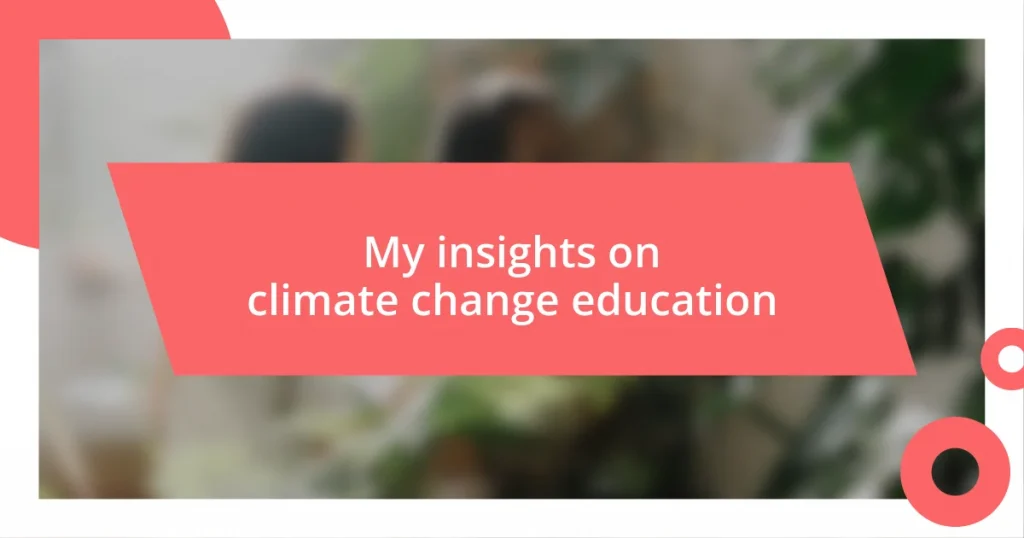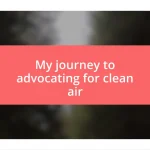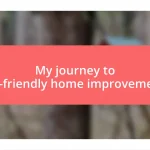Key takeaways:
- Climate change education should evoke emotional connections and personal stories to enhance student engagement and inspire action.
- Climate literacy empowers individuals to make informed decisions, drives policy change, and fosters resilience against environmental challenges.
- Community involvement and creative collaboration, such as tree planting and mural projects, strengthen understanding and commitment to climate issues among students and families.
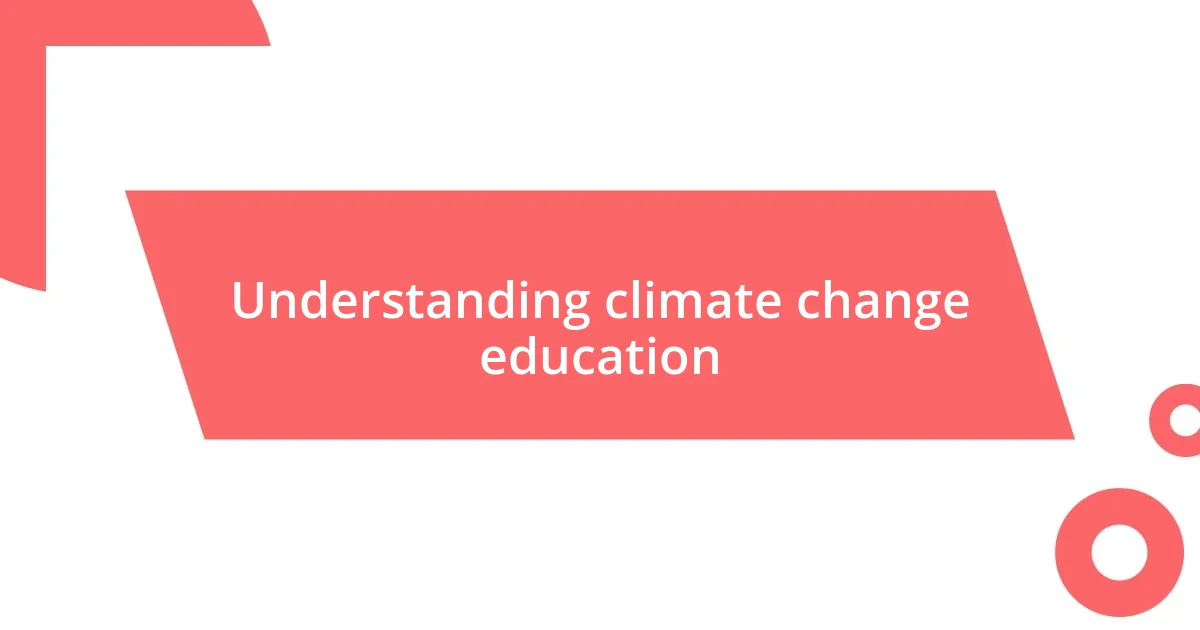
Understanding climate change education
Understanding climate change education goes beyond simply presenting facts; it’s about fostering a deep emotional connection with the planet. I recall attending a workshop where an expert shared personal stories of communities affected by rising sea levels. It struck me—the reality of climate change isn’t just data-driven; it’s human.
When I think about effective climate change education, I can’t help but wonder: How can we motivate young minds to actively engage with these challenges? From my experience in various educational settings, I’ve seen students light up when they understand that they have the power to make a difference, whether through local activism or sustainable practices in their everyday lives.
Furthermore, education should instill a sense of urgency and responsibility. I remember a student project that focused on the impact of plastic waste in our oceans. Watching those teenagers passionately advocate for reducing plastic use opened my eyes to how informed discussions can ignite action. Isn’t it inspiring how knowledge can transform awareness into meaningful change?
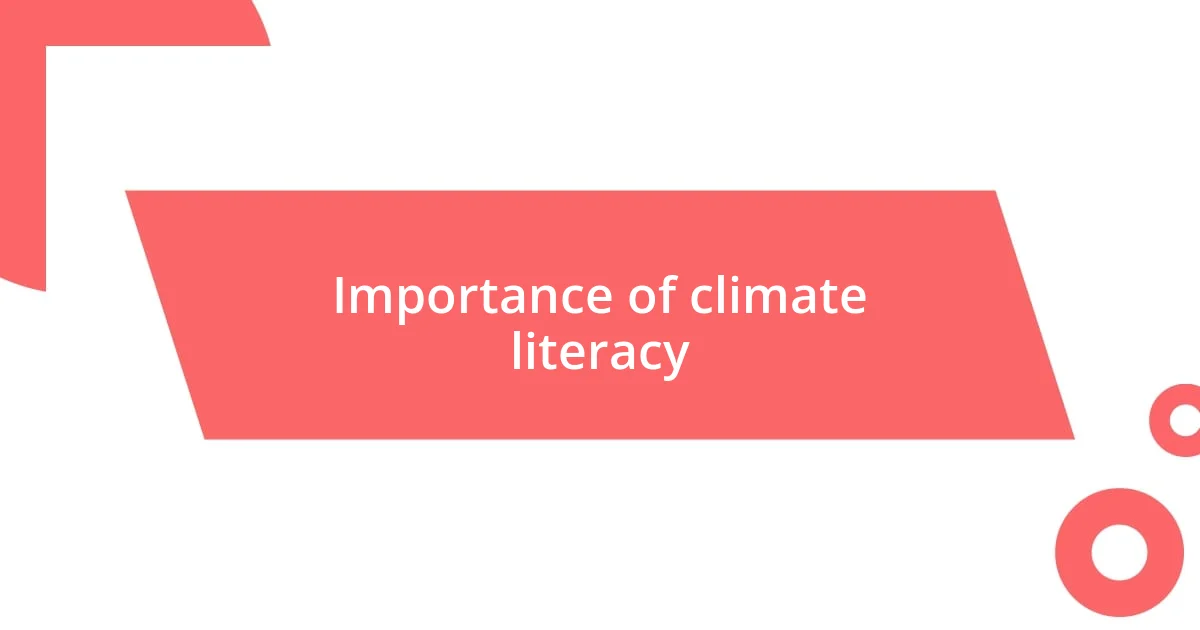
Importance of climate literacy
Climate literacy is crucial because it empowers individuals to understand complex issues and make informed decisions. When I first dug deep into the science behind climate change, I realized how interconnected everything is—our choices about food, energy, and transportation all tie back to our planet’s health. One particular moment that stands out for me was during a community event where we discussed reducing carbon footprints. It dawned on me that every small action counts when we come together with a shared understanding.
Moreover, a well-informed society can drive policy change. I remember my local climate action group mobilizing support for renewable energy initiatives after conducting a workshop on energy sources. This collective awareness shifted not just individual mindsets but also influenced local government decisions. It’s a testament to how education boosts civic engagement—those empowered with knowledge are more likely to advocate for the changes our planet desperately needs.
Lastly, climate literacy fosters resilience. I once met a teacher who integrated climate action into her curriculum, teaching students not just about the problem but also about adaptation strategies. This approach imbued students with a sense of agency, preparing them to face environmental challenges head-on. It’s fascinating how education can transform fear into action and hope, equipping future generations with the tools they need to create a sustainable future.
| Aspect | Importance of Climate Literacy |
|---|---|
| Empowerment | Enables individuals to understand climate issues and make informed choices. |
| Policy Change | Informed communities can drive necessary reforms for sustainability. |
| Resilience | Education equips future generations to tackle environmental challenges creatively. |
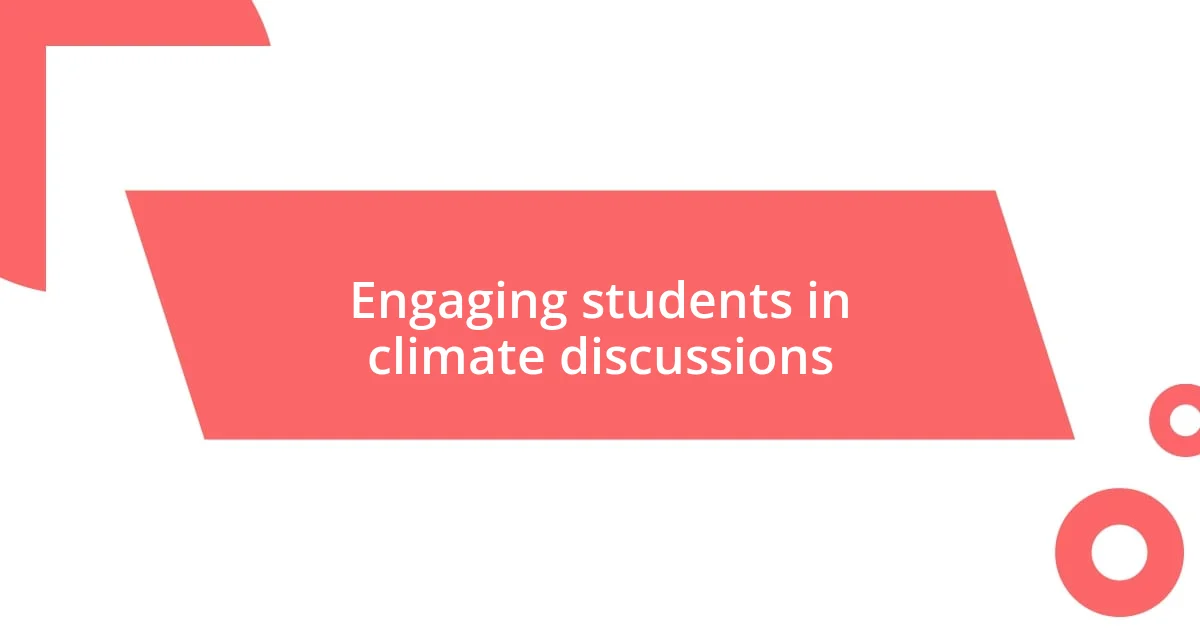
Engaging students in climate discussions
When it comes to engaging students in climate discussions, I’ve found that creating a safe space for open dialogue is essential. I remember a classroom where students were encouraged to share their feelings about climate change—surprisingly, many expressed anxiety or frustration. This emotion often acts as a powerful catalyst for deeper conversations. It’s fascinating to witness how, when students can express their fears, they naturally transition into discussing solutions and inspiring each other to take action.
- Incorporate interactive activities: Hands-on projects, like community clean-ups or recycling drives, help students connect personally with climate issues.
- Use storytelling: Sharing real-life experiences, much like how my own fears transitioned into action, can resonate deeply and motivate students.
- Encourage debate: Allowing students to explore different perspectives on climate policies fosters critical thinking and active engagement.
Facilitating these discussions not only keeps the topic relevant but also empowers students to take ownership of their learning journey. I’ve seen firsthand how passionate dialogue can transform a simple classroom lesson into a lifelong commitment to environmental stewardship.
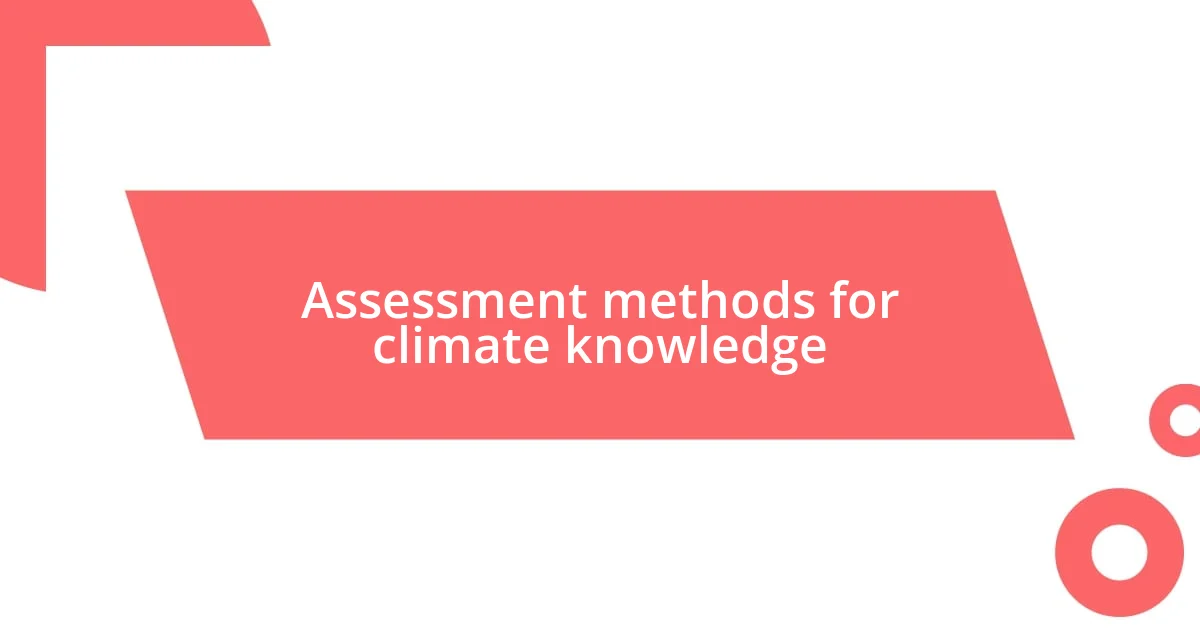
Assessment methods for climate knowledge
Assessing climate knowledge can take many forms, and I’ve seen the power of using diverse assessment methods to really gauge understanding. For instance, I once implemented a project-based assessment in a class where students created a documentary about local climate issues. This approach not only revealed their grasp of concepts but also sparked their enthusiasm for research and storytelling. It’s incredible to see how hands-on experiences lead to a deeper connection with the material.
Another method I found effective is reflective journaling. I encouraged students to maintain journals documenting their thoughts and feelings about climate change over the semester. Reading their entries was eye-opening; many of them articulated their evolving understanding of climate science and personal responsibility. It made me wonder—how often do we allow ourselves that space to reflect and grow?
Finally, quizzes can sometimes feel archaic, but when I made them interactive, they transformed into engaging learning tools. I remember using an online platform where students answered questions through games. The competitive environment drove them to learn more, as they not only wanted to score well but also to share their knowledge with peers. This blend of fun and learning reinforced their understanding of critical climate concepts in a memorable way. Isn’t it amazing how we can turn assessments into opportunities for exploration and growth?
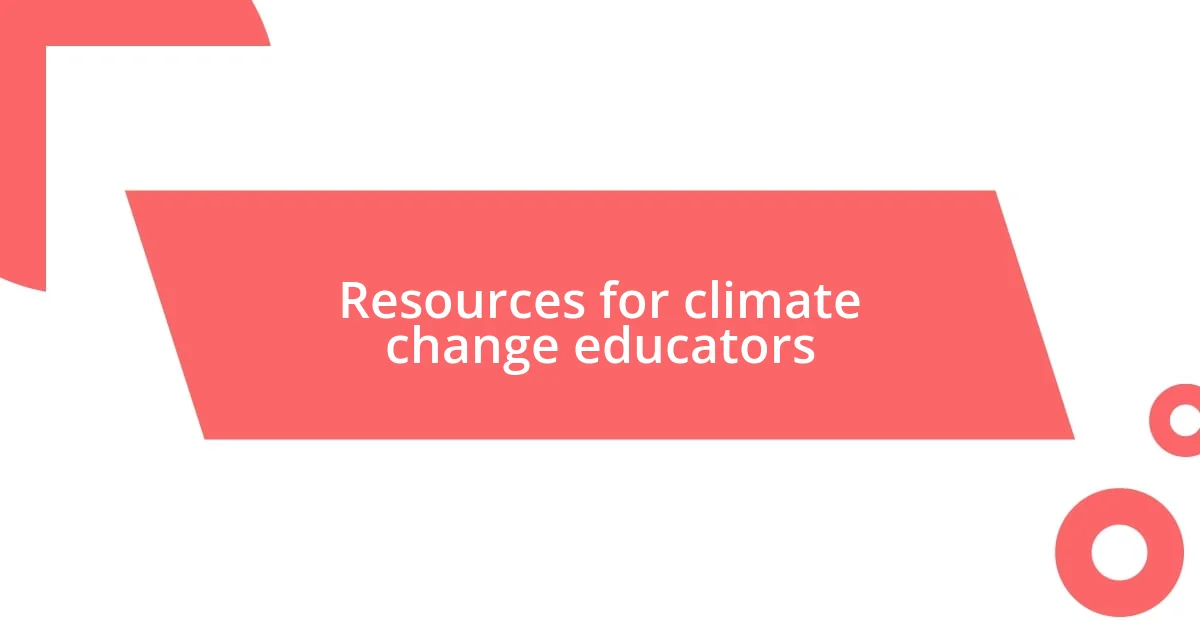
Resources for climate change educators
When it comes to resources for climate change educators, I find that engaging with online platforms can be incredibly effective. For example, I often turn to World Wildlife Fund’s (WWF) educational resources, which provide a wealth of lesson plans and activities tailored to different age groups. These materials not only support educators but also empower students with actionable knowledge, fostering a sense of agency.
I also recommend getting connected with local environmental organizations. I remember collaborating with a local non-profit for a workshop that equipped my students with real-world solutions for our community. The experience was both eye-opening and energizing; students left feeling inspired, armed with practical tools to combat climate issues. Isn’t it remarkable how partnerships can amplify our teaching efforts and create meaningful local impact?
Don’t overlook the value of social media and online forums, either. I often engage with climate education groups on platforms like Facebook and Twitter, where educators share innovative ideas and tips. Just the other day, I stumbled upon a discussion about incorporating climate-focused literature into the curriculum—an idea I plan to explore further in my own classroom. These platforms create a vibrant community where I constantly learn and grow alongside fellow educators.
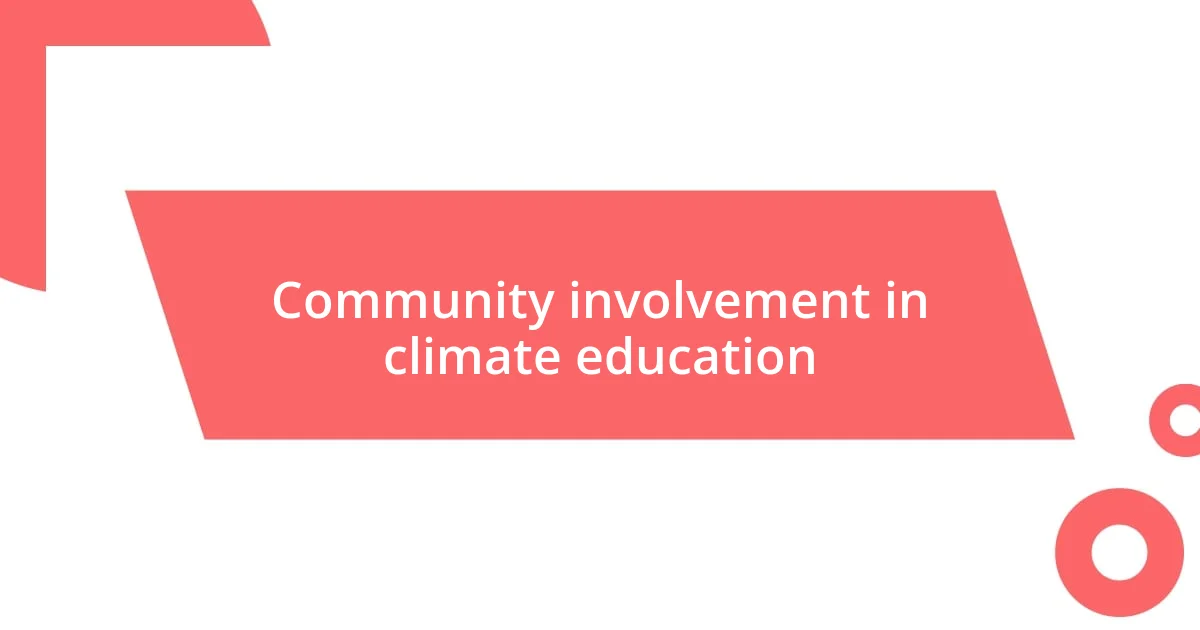
Community involvement in climate education
Community involvement in climate education is crucial for fostering a deeper understanding of environmental issues. I distinctly remember a neighborhood event where families gathered to plant trees together. Watching parents and children collaborate instilled a sense of responsibility and connection to nature. Isn’t it inspiring to see communities come together like that?
Engaging local leaders can also amplify the impact of climate education. I once facilitated a town hall meeting where community members discussed climate resilience plans. The energy in the room was palpable; it reminded me how powerful it is to involve diverse voices and perspectives. What if more communities adopted this approach to clarify their environmental goals?
Additionally, workshops that blend art and science can be transformative. During a local mural project, artists worked with students to visualize climate issues creatively. The result was not just beautiful artwork, but also a powerful conversation starter about climate change in our neighborhood. How often do we utilize creativity to bridge the gap between understanding and action?










